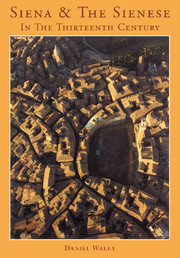Book contents
- Frontmatter
- Contents
- List of illustrations
- List of tables
- Preface
- Acknowledgements
- Glossary
- Abbreviations
- Chronology of principal political events and developments
- 1 Siena
- 1 Setting
- 2 People
- 3 Institutions
- 4 Oligarchy
- 5 Problems
- 6 Religion
- 7 Assumptions
- 8 Revenue
- 9 Expenditure
- 10 Continuity and change
- General Index
- Index of personal names
- Index of places
3 - Institutions
Published online by Cambridge University Press: 03 December 2009
- Frontmatter
- Contents
- List of illustrations
- List of tables
- Preface
- Acknowledgements
- Glossary
- Abbreviations
- Chronology of principal political events and developments
- 1 Siena
- 1 Setting
- 2 People
- 3 Institutions
- 4 Oligarchy
- 5 Problems
- 6 Religion
- 7 Assumptions
- 8 Revenue
- 9 Expenditure
- 10 Continuity and change
- General Index
- Index of personal names
- Index of places
Summary
THE PRINCIPAL OFFICES
The senior official of the commune of Siena was the Podestà (Latin potestas = power); this had been the case, as in most of the Italian cities, since the early thirteenth century. The matter of his election had to be raised each year before the end of the first week in September, to allow time for the new Podesta to take up his annual office in November. The selection was the responsibility of three electors drawn by lot from the members of the Council, who proceeded to put forward four names; their choice required confirmation by the Council. The electors were not allowed to leave Siena between the presentation of their list and the receipt of an acceptance by one of the candidates proposed. These arrangements, which applied in mid century and in the 1260s, had been modified by the early fourteenth century, when the Sienese governing officials, the Nine, sent an emissary four months before the choice had to be made to places selected by them to seek out ‘buoni e sufficienti e convenevoli huomini e amatori de la santissima romana Chiesa e del prosperevole stato della città’. At the next stage the choice was made by the Nine themselves, reinforced by the consuls of the merchant gild, the consuls of the knights and sixty men chosen for the purpose. The individual named (at this period for a six-month tenure) had to be aged at least thirty and to have been knighted by the time of assuming office, if not previously.
- Type
- Chapter
- Information
- Siena and the Sienese in the Thirteenth Century , pp. 42 - 76Publisher: Cambridge University PressPrint publication year: 1991



